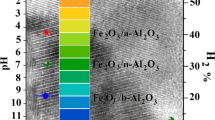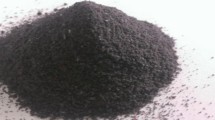Abstract
The effect of microstructure of high density polyethylene (HDPE) on catalytic degradation over fluid catalytic cracking (FCC) catalyst and Nano clay is investigated. An ethylene/1-hexene copolymer (HDPE) was fractionated based on 1-hexene content to different fractions using preparative temperature rising elution fractionation (P-TREF) method. The short chain branch (SCB) content of each fraction calculated based on 1H NMR results. The homogenous SCB content fractions were subsequently analyzed using TGA and thermal degradation behavior of samples were compared with catalytic degradation. The results showed that FCC, in contrast to nano clay, is more sensitive to microstructure of HDPE during catalytic degradation. Therefore, linear chains can start degradation sooner on FCC than the branched chains. In comparison of nano clay and FCC it was found that the nano clay, reduces temperature at maximum degradation rate (Tmax), but FCC reduces the T5% and Tmax significantly.








Similar content being viewed by others
References
Miskolczi N, Bartha L, Deák G (2006) Thermal degradation of polyethylene and polystyrene from the packaging industry over different catalysts into fuel-like feed stocks. Polym Degrad Stab 91(3):517–526
Simpson D, Vaughan G (2003) Ethylene polymers, LLDPE. Encycl Polym Sci Technol
Miskolczi N et al (2004) Thermal and thermo-catalytic degradation of high-density polyethylene waste. J Anal Appl Pyrolysis 72(2):235–242
Miskolczi N, Ateş F (2016) Thermo-catalytic co-pyrolysis of recovered heavy oil and municipal plastic wastes. J Anal Appl Pyrolysis 117:273–281
Sharuddin SDA et al (2016) A review on pyrolysis of plastic wastes. Energy Convers Manag 115:308–326
Kunwar B et al (2016) Plastics to fuel: a review. Renew Sustain Energy Rev 54:421–428
Lin Y-H (2009) Production of valuable hydrocarbons by catalytic degradation of a mixture of post-consumer plastic waste in a fluidized-bed reactor. Polym Degrad Stab 94(11):1924–1931
Wang DK, He H, Yu P, Flame-retardant (2016) and thermal degradation mechanism of low-density polyethylene modified with aluminum hypophosphite and microencapsulated red phosphorus. J Appl Polym Sci 133(13)
Dixit S, Dixit G, Verma V (2016) Thermal degradation of polyethylene waste and jute fiber in oxidative environment and recovery of oil containing phytol and free fatty acids. Fuel 179:368–375
Salmiaton A, Garforth A (2007) Waste catalysts for waste polymer. Waste Manag 27(12):1891–1896
Vasudeo RA et al (2016) Sustainable development through feedstock recycling of plastic wastes. In Macromolecular Symposia. Wiley Online Library, Hoboken
Paraschiv M et al (2016) Energy and monomer recovery from polymer wastes. in 2016 7th International Renewable Energy Congress (IREC). IEEE
Abbas-Abadi MS, Haghighi MN, Yeganeh H (2013) Evaluation of pyrolysis product of virgin high density polyethylene degradation using different process parameters in a stirred reactor. Fuel Process Technol 109:90–95
Marcilla A, del Remedio Hernandez M, García ÁN (2008) Degradation of LDPE/VGO mixtures to fuels using a FCC equilibrium catalyst in a sand fluidized bed reactor. Appl Catal A 341(1):181–191
Liu H et al (2007) A novel FCC catalyst synthesized via in situ overgrowth of NaY zeolite on kaolin microspheres for maximizing propylene yield. Catalysis today 125(3):163–168
Boerefijn R, Gudde N, Ghadiri M (2000) A review of attrition of fluid cracking catalyst particles. Advanced. Powder Technol 11(2):145–174
Marcilla A et al (2003) Kinetic study of polypropylene pyrolysis using ZSM-5 and an equilibrium fluid catalytic cracking catalyst. J Anal Appl Pyrolysis 68:467–480
Seifali Abbas-Abadi M et al (2015) Estimation of pyrolysis product of LDPE degradation using different process parameters in a stirred reactor. Polyolefins J 2(1):39–47
Wong S et al (2016) Parametric study on catalytic cracking of LDPE to liquid fuel over ZSM-5 zeolite. Energy Convers Manag 122:428–438
Miandad R et al (2016) Catalytic pyrolysis of plastic waste: a review. Process Saf Environ Prot 102:822–838
Aboulkas A et al (2007) Kinetics of co-pyrolysis of Tarfaya (Morocco) oil shale with high-density polyethylene. Oil Shale 24(1):15–34
Carmo N et al (2016) Coprocessing of waste plastic and hydrocarbons over MFI (HZSM-5). Int J Chem Kinet 48(6):329–336
Abbas-Abadi MS, Haghighi MN, Yeganeh H (2012) The effect of temperature, catalyst, different carrier gases and stirrer on the produced transportation hydrocarbons of LLDPE degradation in a stirred reactor. J Anal Appl Pyrolysis 95:198–204
Abbas-Abadi MS et al (2013) The effect of melt flow index, melt flow rate, and particle size on the thermal degradation of commercial high density polyethylene powder. J Therm Anal Calorim 114(3):1333–1339
Abbas-Abadi MS, Haghighi MN, Yeganeh H (2012) Effect of the melt flow index and melt flow rate on the thermal degradation kinetics of commercial polyolefins. J Appl Polym Sci 126(5):1739–1745
Lee K-H et al (2002) Comparison of plastic types for catalytic degradation of waste plastics into liquid product with spent FCC catalyst. Polym Degrad Stab 78(3):539–544
Olazar M et al (2009) Influence of FCC catalyst steaming on HDPE pyrolysis product distribution. J Anal Appl Pyrolysis 85(1):359–365
Cardona SC, Corma A (2002) Kinetic study of the catalytic cracking of polypropylene in a semibatch stirred reactor. Catal Today 75(1):239–246
Rezende MJ, Pinto AC (2016) Esterification of fatty acids using acid-activated Brazilian smectite natural clay as a catalyst. Renew Energy 92:171–177
Zhao Y-H, Ma F, Tang K (2016) Preparation of acid-activated montmorillonite and its application. Mar Georesour Geotechnol 34(8):741–746
Zhu J et al (2001) Fire properties of polystyrene-clay nanocomposites. Chem Mater 13(10):3774–3780
Chirtoc M et al (2012) Photothermal characterization of nanocomposites based on high density polyethylene (HDPE) filled with expanded graphite. Int J Thermophys 33(10–11):2110–2117
Jang B-S et al (2005) Degradation of polystyrene using montmorillonite clay catalysts. React Kinet Catal Lett 86(1):75–82
Tae J-W et al (2004) Catalytic degradation of polystyrene using acid-treated halloysite clays. Solid State Ionics 172(1):129–133
Cho K-H et al (2006) Performance of pyrophyllite and halloysite clays in the catalytic degradation of polystyrene. React Kinet Catal Lett 88(1):43–50
Hanley HJM et al (2001) A SANS study of organoclay dispersions. Int J Thermophys 22(5):1435–1448
Skumiel A et al (2011) Thermophysical and magnetic properties of carbon beads containing nickel nanocrystallites. Int J Thermophys 32(9):1973–1985
Cullis CF, Hirschler M (1981) The combustion of organic polymers. Clarendon Press Oxford, Oxford
Assumption H et al (2006) High resolution solution and solid state NMR characterization of ethylene/1-butene and ethylene/1-hexene copolymers fractionated by preparative temperature rising elution fractionation. Polymer 47(1):67–74
Cheruthazhekatt S et al (2013) Combination of TREF, high-temperature HPLC, FTIR and HPer DSC for the comprehensive analysis of complex polypropylene copolymers. Anal Bioanal Chem 405(28):8995–9007
Clark EJ, Hoffman JD (1990) Crystallization and fibril formation in polymers. Int J Thermophys 11(1):225–237
Kebritchi A et al (2014) The role of 1-hexene comonomer content in thermal behavior of medium density polyethylene (MDPE) synthesized using Phillips catalyst. Polyolefins J 1(2):117–129
Kebritchi A et al (2015) The interrelationships between microstructure and melting, crystallization and thermal degradation behaviors of fractionated ethylene/1-butene copolymer. Iran Polym J 24(4):267–277
Kebritchi A et al (2015) The ablative behavior of high linear chains and its role in the thermal stability of polyethylene: a combined P-TREF–TGA study. Polym Int 64(10):1316–1325
Kebritchi A et al Thermal behavior of fractionated ethylene/1-octene copolymer at high temperatures: Effect of hexyl branch conten. J Polym Res, to be published. Under Review.
ASTMD5017 (2009) Standard test method for determination of linear low density polyethylene (LLDPE) composition by carbon-13 nuclear magnetic resonance pp. 1–8
Zhang M, Wanke SE (2003) Quantitative determination of short-chain branching content and distribution in commercial polyethylenes by thermally fractionated differential scanning calorimetry. Polym Eng Sci 43(12):1878–1888
Mittal V (2011) Thermally stable and flame retardant polymer nanocomposites. Cambridge University Press, Cambridge
Ribeiro SP, Estevão LR, Nascimento RS (2016) Effect of clays on the fire-retardant properties of a polyethylenic copolymer containing intumescent formulation. Sci Technol Adv Mater 9(2):024408
Benco L, Demuth T, Hutschka F (2003) Catalytic conversion of hydrocarbons over zeolites from first principles. Comput Mater Sci 27(1):87–95
Lee K-H, Shin D-H, Seo Y-H (2004) Liquid-phase catalytic degradation of mixtures of waste high-density polyethylene and polystyrene over spent FCC catalyst. Effect of mixing proportions of reactants. Polym Degrada Stab 84(1):123–127
Manos G, Garforth A, Dwyer J (2000) Catalytic degradation of high-density polyethylene over different zeolitic structures. Ind Eng Chem Res 39(5):1198–1202
Acknowledgements
We thank Dr. Christian Scheffler and Dr. Regine Boldt from Leibniz-Institut für Polymerforschung (IPF) Dresden e.V. (Germany) for thermal analysis and morphological measurements and discussions.
Author information
Authors and Affiliations
Corresponding author
Rights and permissions
About this article
Cite this article
Kebritchi, A., Nekoomansh, M., Mohammadi, F. et al. Effect of Microstructure of High Density Polyethylene on Catalytic Degradation: A Comparison Between Nano Clay and FCC. J Polym Environ 26, 1540–1549 (2018). https://doi.org/10.1007/s10924-017-1053-y
Published:
Issue Date:
DOI: https://doi.org/10.1007/s10924-017-1053-y




